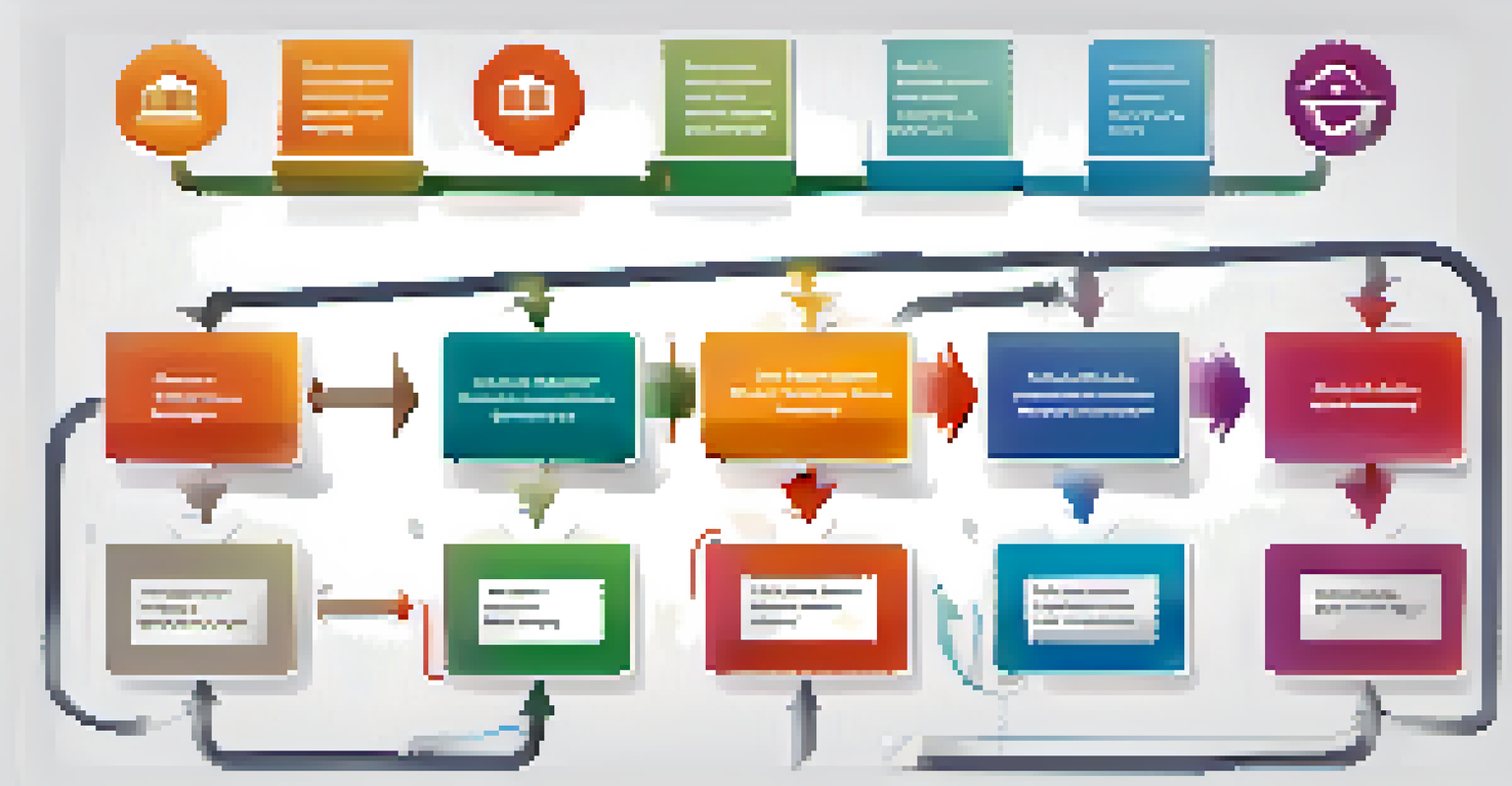Measuring ITSM Success: KPIs and Metrics to Track

Understanding ITSM and Its Importance in Organizations
IT Service Management (ITSM) is a strategic approach to designing, delivering, managing, and improving the way IT is used within an organization. It helps ensure that IT services align with business needs, enhancing overall efficiency and productivity. By implementing ITSM best practices, companies can streamline processes and improve customer satisfaction.
What gets measured gets managed.
In today's fast-paced digital landscape, organizations must adapt quickly to changes and demands. A robust ITSM framework allows businesses to respond effectively to these challenges. This adaptability is crucial for maintaining a competitive edge and ensuring that IT supports broader business objectives.
Ultimately, measuring the success of ITSM initiatives is essential. By tracking specific Key Performance Indicators (KPIs) and metrics, organizations can assess the effectiveness of their IT services, identify areas for improvement, and make informed decisions to enhance service delivery.
Key Performance Indicators: What Are They?
Key Performance Indicators (KPIs) are measurable values that demonstrate how effectively an organization is achieving its key business objectives. They provide insight into the performance of processes and help gauge the success of ITSM strategies. KPIs can vary depending on the goals and objectives of an organization, making them tailored tools for measurement.

For ITSM, KPIs can cover various aspects, including service quality, efficiency, and user satisfaction. By establishing relevant KPIs, IT departments can track their progress and ensure they are meeting their targets. This data-driven approach promotes accountability and encourages continuous improvement in service delivery.
ITSM Enhances Business Efficiency
IT Service Management (ITSM) aligns IT services with business needs, improving overall efficiency and productivity.
It's important to choose KPIs wisely, focusing on those that align with the organization's goals. For example, if a company prioritizes customer satisfaction, metrics related to user feedback and response times would be particularly relevant. This alignment ensures that efforts to measure success are meaningful and actionable.
Critical KPIs for Measuring ITSM Success
Several KPIs are essential for measuring the success of ITSM initiatives. Among these, First Contact Resolution (FCR) is a vital metric that indicates the percentage of incidents resolved on the first interaction. A high FCR rate suggests efficiency and effectiveness in service delivery, ultimately leading to increased customer satisfaction.
The only way to do great work is to love what you do.
Another important KPI is Service Level Agreement (SLA) compliance, which measures the percentage of incidents handled within the agreed-upon timeframes. Monitoring SLA compliance helps organizations ensure they meet their commitments to users, fostering trust and reliability in IT services.
Customer Satisfaction Score (CSAT) is also a key metric that gauges user satisfaction with IT services. Collecting feedback through surveys after service interactions can provide valuable insights into user experiences and highlight areas needing improvement. This ongoing feedback loop is crucial for refining ITSM practices.
Utilizing Incident Management Metrics Effectively
Incident management metrics are crucial for understanding the efficiency of IT service processes. Metrics such as the number of open incidents, mean time to resolve (MTTR), and incident backlog provide a comprehensive view of how well an organization handles incidents. Tracking these metrics can reveal trends and potential bottlenecks in service delivery.
For instance, if the MTTR is consistently high, it may indicate issues within the incident resolution process. By identifying these weaknesses, organizations can implement targeted improvements, such as additional training for support staff or enhancing knowledge management resources.
KPIs Drive ITSM Success
Key Performance Indicators (KPIs) help organizations measure the effectiveness of their ITSM strategies and identify areas for improvement.
Additionally, monitoring the incident backlog can help prioritize resources more effectively. A growing backlog may signal the need for additional staff or process adjustments to better manage workloads. By staying on top of these metrics, organizations can ensure a proactive approach to incident management.
The Role of Change Management Metrics in ITSM
Change management is a critical component of ITSM, and measuring its success is essential for minimizing disruptions and maximizing efficiency. Metrics such as the number of successful changes, change failure rate, and time to implement changes provide insights into the effectiveness of change management processes.
For example, a high change success rate indicates that the change management process is working well, resulting in minimal service interruptions. Conversely, a high change failure rate might suggest that further investigation and adjustments are needed to improve planning and execution.
Additionally, tracking the time it takes to implement changes can help organizations identify areas for improvement. By streamlining change processes and reducing delays, IT teams can enhance their agility and responsiveness to business needs.
Employee Productivity Metrics in ITSM
Employee productivity metrics play a vital role in assessing the effectiveness of ITSM practices. Metrics such as ticket resolution time, workload distribution, and utilization rates help organizations understand how efficiently their IT teams are functioning. Monitoring these metrics can highlight areas for improvement and optimize resource allocation.
For instance, if ticket resolution times are consistently high, it may indicate a need for additional training or support resources. By addressing these issues, organizations can empower their teams to work more efficiently and effectively.
User Feedback Fuels Improvement
Tracking user satisfaction metrics allows IT teams to respond to feedback and enhance service quality, fostering trust and satisfaction.
Furthermore, analyzing workload distribution can help identify imbalances that may lead to burnout or decreased morale. By ensuring that workloads are evenly distributed, organizations can foster a healthier work environment and encourage sustained productivity.
Tracking User Satisfaction and Feedback Metrics
User satisfaction is a crucial aspect of ITSM success, and tracking relevant metrics can provide valuable insights into the user experience. Metrics such as Net Promoter Score (NPS) and Customer Satisfaction Score (CSAT) can help organizations gauge how well their IT services are meeting user needs. Gathering feedback regularly ensures that IT teams remain responsive to user expectations.
For example, by implementing post-service surveys, organizations can collect feedback on specific interactions and identify trends over time. This data can be instrumental in pinpointing areas for improvement and enhancing overall service quality.

Moreover, actively addressing user feedback demonstrates a commitment to continuous improvement. When users see their concerns being addressed, it can lead to increased trust and satisfaction, ultimately benefiting the organization as a whole.
Conclusion: The Importance of Measuring ITSM Success
Measuring ITSM success through relevant KPIs and metrics is essential for organizations looking to improve their IT service delivery. By tracking performance, organizations can identify strengths and weaknesses, enabling them to make informed decisions for continuous improvement. This proactive approach ultimately leads to enhanced user satisfaction and better alignment with business goals.
Furthermore, embracing a culture of measurement fosters accountability within IT teams, encouraging them to take ownership of their roles in service delivery. This accountability can drive innovation and motivate teams to strive for excellence in their work.
In conclusion, the right metrics can transform the way organizations approach ITSM, turning data into actionable insights that lead to lasting success. By prioritizing measurement, organizations can ensure that their IT services are not just functional but also effective and aligned with the needs of the business.